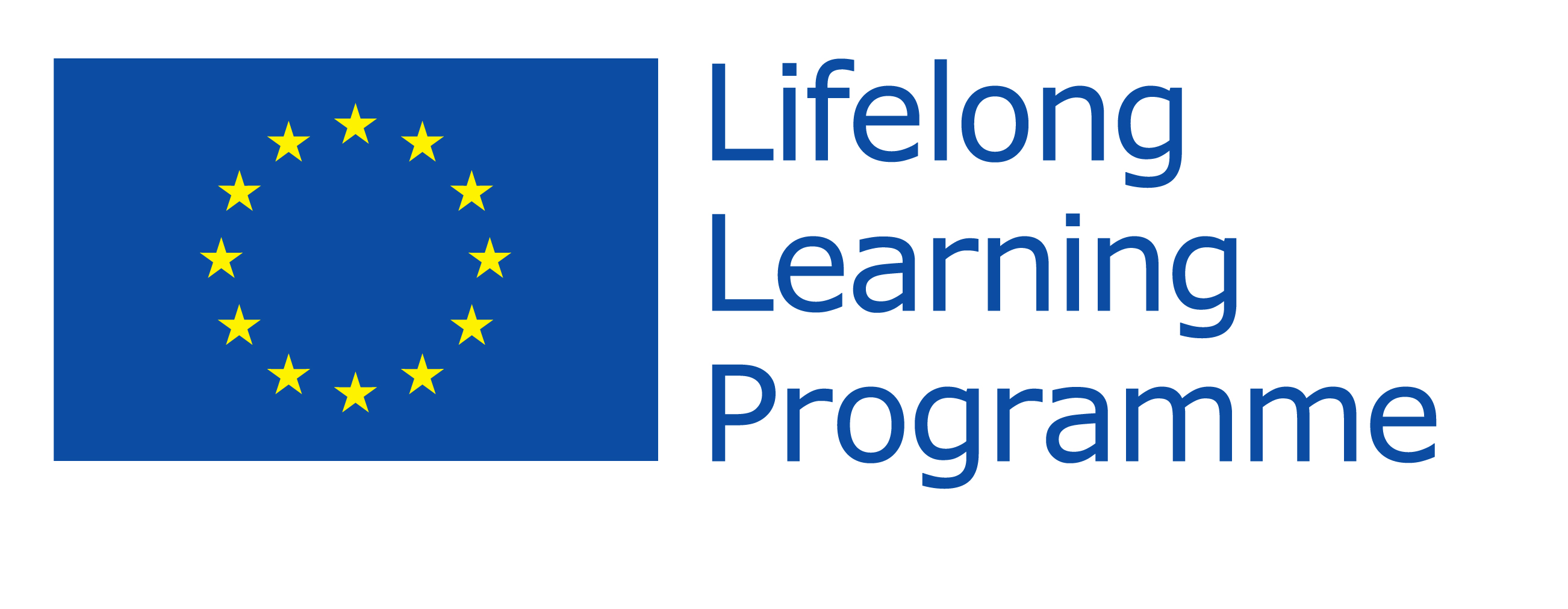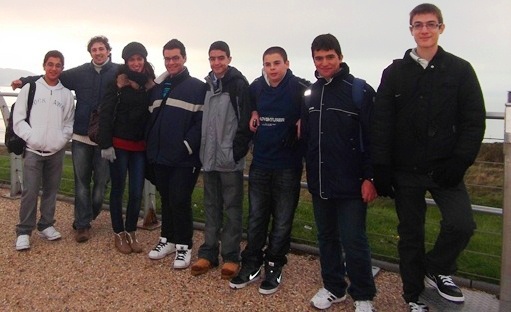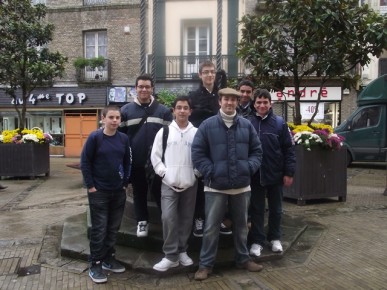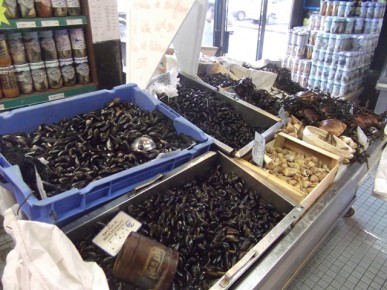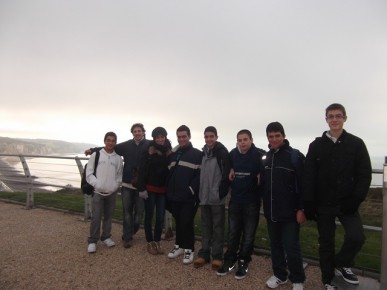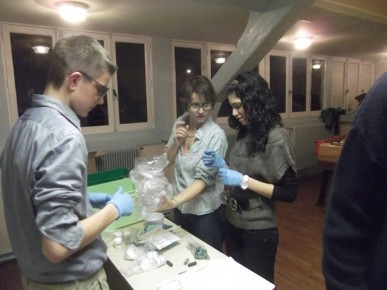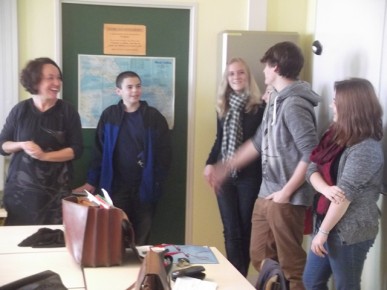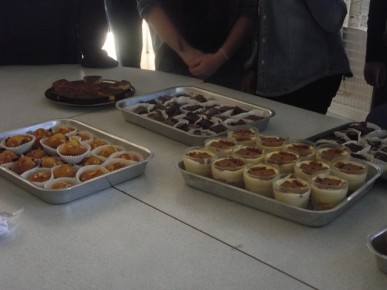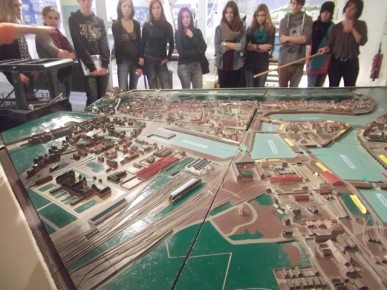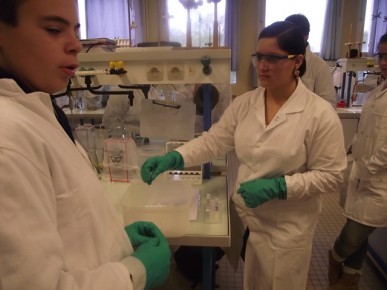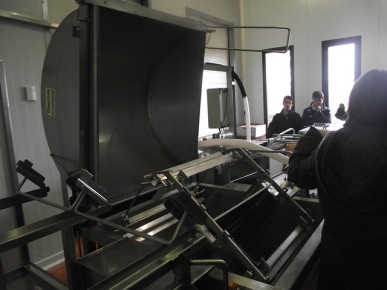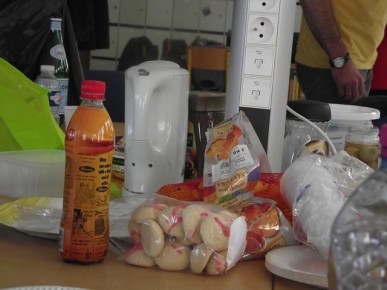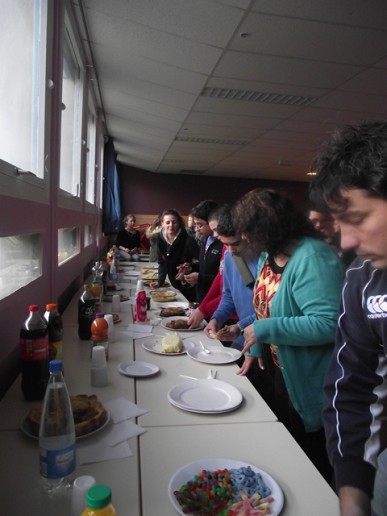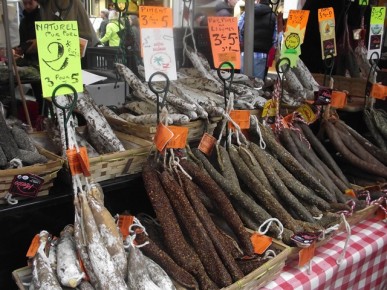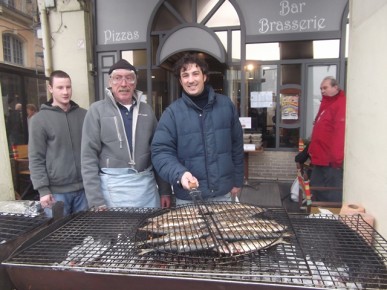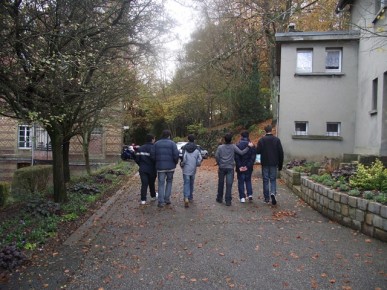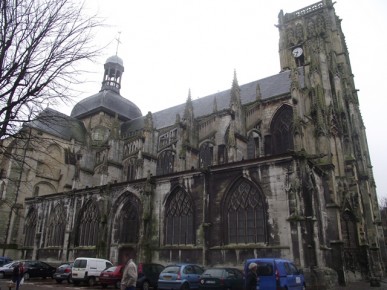Reflections on our visit to Dieppe as part of the Comenius Project Food for Thought.
Our visit to Dieppe would not have been realised without the meticulous planning and constant communication with the hosting school in France. Emma Avery, a fellow teacher of English at the Lycée du Golf in Dieppe, organised the programme which ranged from joining in lessons at her school, to cooking sessions as well as laboratory sessions during which experiments involving a great deal of Chemistry were carried out together with French and the other participants from Plochingen, Germany.
Day one
During the first day the host gave us a brief tour of the coastal town we were staying in. We discovered that it has a long history, often associated with military ventures, spanning from the Hundred Years’ War to the Second World War.
As we toured a small local market, we were treated to a tasting session of the local famous cheese; although not all members of the group appreciated the strong whiff of Neufchâtel.
During the afternoon, we were invited to join an art class, during which we gave a short presentation on the Maltese Islands before we discussed our first fieldwork: that of a visit to the beach adjacent to Pourville-sur-Mer, very popular with the impressionist Claude Monet.
Our partnership aims to explore food from diverse aspects; in France we plan to explore the chemical properties of different foods as well as manipulating the chemical properties of food to create products, such as cosmetics. Together with the German group, this was our objective. In fact, we managed to conduct a Chemistry session during which we produced a honey beauty mask which smoothens skin. Among the ingredients we used were lemon extract, sodium bicarbonate, Guar Gum, Nigella oil, Lemon essential oil and powdered honey.
From this activity, students realized that one can make his own natural self-made products by mixing foodstuffs and natural ingredients which are good for the skin at concentrations which are effective without the need of adding chemicals for fragrance or to extend shelf-life. Many commercial productsoften contain chemicals that are known to cause allergic reactions. There are many chemicals derived from natural sources which are chemically modifide i order to enhance their natural properties and to make them useful for cosmetic purposes. From this activity, students noted that it possible to make cosmetics totally free of chemicals, but adding valuable chemicals improve product quality. In our case, students had to add Cosgard conservative which prevents the growth of mould or bacteria in the cosmetic product.
The result was quite successful. In fact, although of slightly varying consistencies, all participants managed to create this natural paste with an appealing aromatic citrusy scent. Our students plan to use the finished product as a gift to their parents, if the latter are willing to risk it!
Day two
On Wednesday we were invited to share a presentation on Maltese and Gozitan traditions and their links with our cuisine with many classes at the Lycee du Golf. The presentation was solely the Sacred Heart Seminary students’ work. It was a success, thanks to the inclusion of clear images and our students’ delivery. Often, the audience presented questions to our students, in English, and this served as an ideal opportunity for students from both countries to practise their English.
One must note that this was our students first ever presentation to a foreign audience and although there was an element of anxiety at first, they soon got to grips with the situation and moreover, they were looking forward to subsequent presentations.
During Wednesday morning, our students were involved in a cookery workshop during which they were guided by Mme Tremouille on how to prepare desserts. As shown in the photos, the result was indeed positive and the desserts were then shared with the German students and the French school staff. The writing was on the wall: we were in for a gastronomic treat during our visit to Dieppe. Rumours were already spreading among the female quarters of the participating group, that an addition of a couple of inches in the waistline by the end of our visit was an inescapable destiny.
The afternoon was taken up by a visit to the maritime museum in the historic centre of Dieppe. We learned about the rich maritime history of this port city and its involvement in major wars. Interestingly, the name Dieppe hails from the Middle English word dep akin to the modern English word deep, since the river in Dieppe was deep enough to allow ships to sail into the city from the Channel. It proved to be most convenient for invading English ships during the Hundred Years’ War. The guide also explained to us, with the help of genuine fishing tools, the main fishing techniques used in Dieppe’s waters. The most prized catch is undoubtedly oysters. Dieppe has long been renowned for this popular food and we were shown the iron nets used to harvest this local delicacy. We also learned about what used to be a major economic activity in Dieppe, that of smoking herring. However, the highlight, I must admit, was the tasting session of smoked herring drizzled with lemon juice. Truly a heavenly experience!
The evening was a time reserved for some winding down crowned with a proper French meal. The students also took the opportunity to further their friendships with their German colleagues. The less formal setting encouraged conversation, and loud laughter by the less inhibited members of our group. It was a very fitting end, and it boded well to the success of this partnership.
Day three
Thursday was mostly dedicated to the Chemistry and Biochemistry workshops. All our students are studying Chemistry and this facilitated their participation in the lab sessions.
Chemistry Workshop
During the Chemistry Workshop students had to carry out an experiment using whey protein which is a by-product in cheese production. In line with the theme of this project, Food, it was both relevant and interesting to analyse this valuable portion of milk left after cheese is made. Whey protein concentrate is nowadays processed into a range of dairy products. What is so remarkable is that whey protein is considered to be an anti-aging source since it has many benefits, including bettering the quality of collagen in the skin and hence preventing wrinkles from appearing.
In order to produce whey protein concentrate, a whey solution has to go through a filtration process to remove most of the carbohydrates, fat and lactose from whey. The removal of lactose is ideal for those who are lactose intolerant, therefore the whey concentrate may be used by the latter.
The aim of the experiment was to measure the amount of protein in a retentate obtained by ultrafiltration of whey, compared with a calibration range. The Biuret assay method was used to measure the amount of proteins. This works on the principle that when a solution of proteins is treated with a solution containing copper ions in an alkaline medium, a purple coloration is observed which can then be measured quantitatively using a spectrophotometer. Students could observe the intensity of the colour produced which varied depending on the number of peptide bonds that reacted and hence the number of protein molecules present. The staining agent used in this experiment was Gornall reagent which is composed of copper sulphate, sodium hydroxide, sodium tartrate and potassium iodide.
Our students were encouraged to pair up and work with a French student to prepare the spectrophotometer cuvettes. Students had to transfer ranging volumes of bovine serum albumin, which is the calibration solution, using a pipettor into the cuvettes. They also had to dilute the whey by half with saline solution. Since it was the first time for most of our students to actually use a pipettor, they seemed enthusiastic of managing to transfer the required amount of the solutions. One could observe that if the students had a better background in biotechnology especially in the understanding of the process of ultrafiltration and how the spectrophotometer works, they could have been able to follow the experiment quite easily. However, despite of all this, our students were still willing to understand what was going on and did their best to achieve valid results. Eventually, with the help of the French students, our students managed to collect the data in a chart and draw a calibration curve. Finally, the amount of protein in the tests was calculated.
Biology Lesson
Students had the chance to participate in one of the biology lessons. During this lesson an investigation was carried out in order to determine the % of water content in different food samples. This experiment is based on evaporation process by which the change in mass of the sample can be used to calculate the % of water content in the sample.
Determination of water content is one of the most widely used measurements in food processing because of the significance effect of water on the stability and quality of food. Actually, the determination of water content in food sample is required to verify the validity of raw materials in food manufacturing. The higher the water content in food, the more preservatives are required. This is because most of the microorganisms tend to grow rapidly on food with high water content. For this reason, food material with known high water content is dried to prevent its spoilage by the microorganisms.
Our students were engaged in this experiment by pairing up with a French student with whom they had to work. Each pair of student had a different food sample to analyse. They had to take a small sample of the food and weigh it on an electronic balance before putting it in an oven at a temperature of 70°C. Students had the chance to predict which food sample contains a higher % of water. This exercise allowed the students to communicate and share their ideas and opinions. The food sample was left for 2 days to dry up and then reweighed to find out the change in mass. The % loss in mass could eventually be calculated.
Despite the fact that some of the French students found it rather difficult to speak in English, it could be noted that our students were doing their best to get involved in the experiment.
Day four
As part of the partnership’s theme on food, the group was invited to one of the largest honey producing farms in the region, where the kind host took the trouble to explain the meticulous process of honey production. The variety and distinction of different honeys is quite remarkable. Some of the honeys we saw ranged from the dark, treacle-like Chestnut blossom honey to the fresher, lighter coloured lime blossom honey. We were also offered to indulge in a honeycomb wax and all, which was quite a unique and delicious sensation. The visit was rounded up with a sample gift of honey and a special kind of bread made with honey.
After lunch with the Lycée’s staff, featuring Maltese produce, which our students took care to bring along from Gozo, French homemade food and German chocolate treats, we had a workshop during which we discussed the logbook to be presented by our students as part of the reflection and dissemination stage of the visit to Dieppe.
Soon after the workshop we were told that a farewell party has been organised for us by the students of Mme Tremouille, the cuisine teacher. Albeit brief, French students, teachers and the school’s administration gave us a warm reception, spiced up with many French savouries and sweet delicacies.
Dinner proved to be more of an adventure than we expected. Pizza and pasta was served with a raw egg, which cooked slowly with the food’s own warmth, radiating after it was plated. This did raise a few Maltese eyebrows but life would be quite dull without a good measure of an adventurous spirit, so most of us tucked in without too much hesitation.
After the hearty meal, we trod towards the hostel, our dear host Emma promising that the following day was to be another culinary feast of fish and meat in the hugely popular Saturday market in the historical centre of Dieppe. What else could one ask for? Horace’s words drummed in my mind Carpe diem[!] Without any trace of doubt, we had to seize the opportunity for our stay was brief.
Day five
The market provided an exhaustive cross-section of the typical Norman cuisine. The locals do love their meat and seafood. Prices were not too steep, indicating an abundant supply.
The seafood was exceptionally fresh. in fact, stalls selling mussels and oysters were mostly emptied by 10 a.m. we wouldn't have minded feasting on such scrumptious food, like raw oysters, however, time was of the essence and we still had
Undeniably for food lovers, it felt like the Promised Land! Words do not do this experience justice. so we suggest that you absorb the atmosphere captured in the photos below, and perhaps you too, would feel a longing to be in Dieppe's market, and be both a witness, and a player, in such a gastronomic cornucopia.
All in all, this week proved to be most intriguing and engaging. Although there were times when we believed things could have been planned or executed differently, we believe that it was the ideal kick-start to this project. We will work hard at maintaning contact with fellow teachers and students from France and Germany and we cannot wait to host them here in May 2013, to participate in an educational and cultural programme, and to kindle in them a love for Gozo and Malta!
